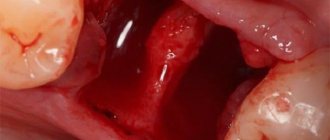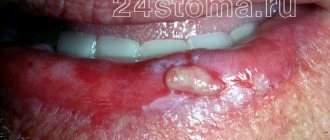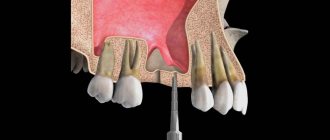From the moment they appear, wisdom teeth often behave unpredictably, grow slowly and crookedly, and the growth process is accompanied by pronounced symptoms. Taking into account such features, it is considered quite natural that the wound bleeds after extraction of the “eight”. In this case, intermittent hemorrhages, which last up to 2-3 days and no more, are considered the norm. They are caused by damage to the periosteum and soft tissues during tooth extraction. When blood is released longer and negative symptoms are observed, then you definitely need to see a dentist to find out the cause of the incessant bleeding.
Causes of bleeding
As a rule, hemorrhage (hemorrhage) occurs as a response to damage during soft tissue surgery or as a result of exposure to certain medications. Such problems usually go away within a few hours after the procedure.
If an ordinary tooth can be pulled out without much difficulty and a cotton swab applied to the wound, then removing third molars is much more difficult. During the manipulation process, it is often necessary to saw the crown of the tooth and pull it out in parts. With deep and curved roots, it is almost impossible to extract them without damaging bone and soft tissue.
In addition, there are also other reasons why the bleeding does not stop after a wisdom tooth has been removed:
- high blood pressure;
- mechanical injuries of a large vessel;
- the patient is taking blood thinning medications, for example, Heparin, Aspirin and others;
- low blood clotting;
- the use of anesthetics, after which the blood vessels dilate. This increases bleeding and slows down the process of clot formation;
- the presence of concomitant diseases can cause heavy bleeding. These include hepatitis, scarlet fever, leukemia, hemophilia and others;
- Overheating of the body or high physical activity immediately after removal increases the risk of hemorrhage.
If immediately in the postoperative period the patient abuses alcoholic beverages or smoking, bleeding can occur as complications.
If wisdom tooth extraction cannot be avoided, then the patient needs to understand that bleeding after such a procedure is a natural and normal process. But even with relative safety, the release of blood requires careful monitoring by both the doctor and the patient himself.
Possible reasons
Bleeding after dental surgery can be divided into two groups. In the first case, we are talking about primary bleeding, which cannot stop on its own after surgery. The second group includes situations where the problem arose only after a day or several days. Usually the reason is non-compliance with the post-operative period: heavy lifting, hot bath, non-compliance with the diet, alcohol, etc.
Let's consider the possible reasons for the first group:
- Violation of blood composition.
- Taking certain groups of medications that cause blood thinning.
- Blood pressure surges.
- Blood diseases.
- Nervous tension.
There are also reasons beyond the patient's control. For example, medical negligence. Some inexperienced dentists damage the tissue too deeply during tooth extraction. Due to deep trauma and damage to blood vessels, the wound does not heal.
Duration of bleeding, normal limits
One of the frequently asked questions by patients who are about to have a wisdom tooth removed is how long does the formed socket bleed and what to do if the bleeding does not stop.
As a rule, after 10-15 minutes after surgery, a blood clot forms in the socket; in some patients, approximately 30-40 minutes may pass before the clot appears. Under no circumstances should this clot be removed, because it protects the wound from infection.
Deviations from the norm are situations where bleeding continues after returning home. But some patients worry in vain, mistaking ichor for blood. If the bleeding in most cases stops within 30-60 minutes, then the discharge of ichor from the wound can be observed for up to 12 hours or longer.
Ichor is a yellowish or colorless liquid with a small blood capacity. Each person may have a different intensity of discharge depending on the characteristics of the body, but in any case this is not a cause for concern.
If blood is released from the wound uncontrollably for a long time, you should inform the doctor about this without waiting for complications.
Prevent bleeding
Tooth extraction is considered a complex procedure, despite the minor amount of damage. Therefore, the patient should follow some of the doctor's instructions to prevent uncontrolled bleeding and minimize the risk of soft tissue inflammation:
- Do not touch or remove the formed blood clot from the wound. In the first 24 hours after surgery, it is not recommended to rinse the mouth.
- Do not touch the injury site with your hands or tongue. This can help break up the blood clot, even if the instruments are sterile.
- During the day after the procedure, you should avoid drinking drinks through a straw, as the vacuum provokes the removal of the blood clot from the socket. If the rule is ignored, the patient experiences increased pain after surgery and the gums swell even more.
- Do not engage in active sports and avoid excessive physical activity for 2 days after removing the wisdom tooth from the socket. Simple housework is acceptable - washing floors, dusting.
- For 24 hours after surgery, avoid going to the sauna or bathhouse, and do not take a hot bath or shower.
- Do not apply warm compresses to the sore area in order to minimize pain or swelling of the cheek. This provokes the spread of the inflammatory process into the deep tissues of the gums.
- For 2 days after the intervention, do not eat too cold or hot food. Otherwise, the pain symptoms intensify.
- You should stop taking spicy foods and carbonated drinks for a while. Dishes with a sour or strong taste provoke a recurrence of the problem.
- Do not chew food on the affected side for 3-7 days.
- If food debris gets into the wound, wash it off with water. Do not use toothpicks or fingers.
- In the first three days after surgery, stop drinking alcohol and smoking. Nicotine and alcohol dry out the mucous membranes of the mouth, thereby increasing pain and increasing the risk of infection of damaged tissues.
24 hours after the intervention, the damaged area of the gum is regularly treated with antiseptic compounds or salt water. After wisdom tooth removal, it is not recommended to carry out hygiene procedures for 8 hours. After this, the teeth are brushed 2 times a day, but all movements are performed with extreme caution so as not to damage the blood clot.
A cold compress is applied to the cheek only in extreme cases, for example, when it is not possible to stop the bleeding for a long time. On the one hand, this procedure helps relieve swelling and reduce pain, but on the other hand, it negatively affects the state of local immunity.
All measures to stop bleeding after wisdom tooth removal are performed within a limited period of time from 7 to 14 days from the date of surgery.
After regeneration of damaged tissues, a person can lead a normal life, since further healing of the hole will occur independently without taking preventive measures. Following the specialist’s recommendations helps to minimize the clinical picture of the problem and accelerate wound healing.
Why doesn't the bleeding stop?
Depending on the physiological characteristics of the body, in some patients a clot forms immediately after surgery, in others the bleeding does not stop for a long time. The reasons for this condition may be different.
High blood pressure
A patient with hypertensive pathology often experiences bleeding from the socket, so if he has such a disease, he should inform the doctor about it before the operation. This will allow you to find an individual approach to a problem patient and prevent possible complications.
Poor blood clotting
If the patient has previously been diagnosed with coagulation disorders, then he is obliged to inform the doctor about the existing problems in order to prevent negative consequences.
Inflammation of the socket
After surgery, the doctor must treat the hole with an antiseptic. But even treatment is not always a guarantee that the bleeding will stop after wisdom teeth are removed. If the socket is a source of infection, the gums usually bleed. In such cases, you should not resort to self-medication, as this can lead to dire consequences. Only a professional specialist can correctly diagnose and prescribe effective treatment.
Purulent accumulations
Before performing any manipulation, the dentist must diagnose the patient’s jaw and make sure there are no pathologies. If there are already purulent accumulations inside the gums, this can provoke heavy bleeding, which is quite difficult to stop.
Damage to the integrity of blood vessels
Due to the irregular growth and location of wisdom teeth in hard-to-reach areas of the oral cavity, the removal of such units is considered a relatively complex dental procedure. Vessels are almost always damaged by surgical instruments. Usually, after several hours, the bleeding stops, but the patient may simply not feel pain due to prolonged exposure to the anesthetic. If large vessels are damaged during surgery, bleeding may occur later and in such cases you should not hesitate to visit the dentist.
Failure to comply with medical recommendations
A rather complex procedure is the removal of a wisdom tooth; bleeding can occur in every patient, even if the operation is performed correctly. The reason for this is improper wound care, which leads to a deterioration in the condition of the hole and the development of an inflammatory process.
Causes of the disease
The development of the disease can be caused by many reasons, from violation of the treatment regimen to serious pathologies. The most common factors:
- Excessively frequent mouth rinsing. Causes blood to be washed out of the socket, facilitating the penetration of bacteria there;
- The entry of food into the hole, which, if cleaned poorly, causes an inflammatory process;
- Low immunity, lack of vitamins, minerals and trace elements in the body;
- Complications after surgery;
- During the operation, oral hygiene was poor; dental plaque got there and was not removed.
Symptoms
The first and main sign of the disease is that the socket in place of the extracted tooth does not heal. If blood constantly oozes out at the removal site, then the formation of a protective blood clot is disrupted and the situation needs to be corrected. Remember, an open wound is not protected from bacteria, so unwanted inflammation can begin there at any moment. When this process occurs, purulent discharge and bad breath appear. It is important not to self-medicate, but to consult a doctor to adjust treatment.
How to stop bleeding
Many patients simply do not understand the complexity of wisdom tooth extraction and when bleeding occurs after the procedure, they do not know how to stop the bleeding. If blood leaks from the gums within a few hours, you can consult a dentist or try to stop it yourself at home.
First aid with gauze swabs
Immediately after pulling out a tooth, the dentist washes the hole, treats it with an antiseptic solution and applies a gauze swab. After 15 minutes you need to spit it out. If this is not done, then after half an hour bacteria will multiply in the blood accumulated on the tampon, and this increases the risk of the inflammatory process.
If bleeding continues after spitting out the tampon, you should make a new tampon from a sterile bandage or gauze, apply it to the gums, firmly clamp your teeth and hold for about 20 minutes. If blood continues to accumulate in the oral cavity, then the procedure with a tampon can be repeated, only now it needs to be slightly moistened in a solution of Miramistin or hydrogen peroxide.
Home Remedies
the blood does not stop after the wisdom tooth is removed by the dentist , then you can use a cold compress. You need to apply a bottle of cold water or a piece of ice wrapped in a cloth to your cheek for a few minutes. Cold relieves pain well, reduces swelling and promotes the rapid formation of a blood clot.
Tea leaves have good tanning properties. To stop bleeding, you can apply a pre-wetted and cooled black tea bag to the place where the tooth was pulled out for 10 minutes. Just don’t apply a hot bag, as the clot that has already formed may melt.
Medications
When the gums bleed after tooth extraction, it is worth purchasing hemostatic drugs at the pharmacy, for example, Dicynon or Etamzilat. The tablets begin to act within 20 minutes after taking them, but the full effect is observed after several hours.
If you experience severe pain, you can take a painkiller. If, after visiting a doctor, an inflammatory process is diagnosed, then a course of antibiotics cannot be avoided; only a specialist must prescribe a specific drug.
In order not to irritate the gums even more, special hemostatic sponges can be applied to the wound. They perfectly normalize coagulation, have an antimicrobial effect and stop bleeding.
Types of violation
Dentists distinguish several types of postoperative bleeding:
- Early or primary. The blood does not stop flowing for a long time immediately after the unit is pulled out. The dentist has to take various measures to stop it.
- Later or secondary. The bleeding quickly stopped at the clinic, but reappeared at home. In such a situation, many people are lost and do not know what to do. There is only one rule - if a negative symptom persists for more than an hour, you should immediately visit a dental surgeon.
Generally speaking, the appearance of blood at the site of the hole should be taken calmly. During extraction, soft tissues and blood vessels are damaged. Therefore, there is nothing strange about bleeding. You need to look at its dynamics. Every day a person’s condition should improve, as should the appearance of the hole in the oral cavity. If this does not happen, then there is some problem. It needs to be identified and eliminated.
Actions after surgery
To prevent hemorrhage and other negative consequences after the removal of a wisdom tooth, the following manipulations are performed directly in the dentist’s office:
- the alveolar socket is cleaned;
- the doctor examines the wound for any remaining tooth fragments;
- damaged tissues are treated with antiseptic agents;
- a tampon is applied.
If bleeding continues after 15-20 minutes, the doctor can inject hemostatic solutions, if large vessels are damaged, bandage them, apply hemostatic agents (fibrin film, sponge, aminocaproic acid, etc.), apply sutures or perform electrocoagulation (cauterization of blood vessels) .
Why is bleeding from a socket dangerous?
Intense bleeding from the gums often frightens patients - they fear dying from blood loss. However, the risk of death after tooth extraction surgery is minimal - this happens in isolated cases, and only with people who suffered from serious illnesses, alcoholism or drug addiction. But problems with internal organs and systems as a consequence of severe bleeding from the gums are quite likely, so it is not recommended to ignore severe bleeding.
Blood clot after tooth extraction
Complications after wisdom tooth removal
Manipulations for the extraction of wisdom teeth should not be underestimated, since even if such procedures are carried out correctly, the patient may experience complications.
Edema
One of the most common consequences that occurs after tooth extraction is swelling. The reason for this may be partial damage to the tissues around the tooth. Usually the swelling goes away within 1-2 days. To speed up the elimination of swelling, this can be done by applying cold compresses to the cheek.
Fever
After a tooth is removed, the body’s natural reaction is to increase body temperature. This condition can last for 2-3 days. To improve your health, you need to take antipyretic drugs, but if the condition does not improve, you should immediately visit a doctor.
Soreness
Pain after extraction of the “eight” occurs due to damage to the periodontal tissues and nerves. If the pain cannot be tolerated, then for relief you need to take analgesics. When painkillers do not help, you should go to the dentist.
Suppuration of the socket
If the wound becomes infected, suppuration may occur. The reasons for the formation of pus may be non-compliance with medical recommendations and improper care of the oral cavity, as well as dental fragments remaining in the tissues after surgery. Self-medication in such cases is inappropriate; only a qualified doctor can prescribe adequate treatment and eliminate the cause of suppuration.
Dry socket
The blood clot must remain in the wound. It protects nerve endings and bone from microbial penetration. Therefore, on the first day after the manipulation, you should not rinse your mouth, and also do not eat hot food.
If a dry socket forms, this leads to increased pain, inflammation and alveolitis. In such cases, the doctor places a tampon with anti-inflammatory gel on the sore spot. Treatment continues until complete healing.
A growth has formed on the gum
After tooth extraction, there is often a complication such as the appearance of a lump on the gum. A growth in such a place indicates the onset of dangerous inflammatory complications. An infection can be caused if the clot is removed carelessly. Another source of infection is leftover food, so dentists prohibit patients from eating for several hours after surgery. During this time, a clot should form in the wound, protecting the gums from infection.
If a growth has formed on the gum, it may be an allergy to the anesthetics used or mechanical damage. Often a growth forms where the injection was given; such a new growth contains liquid inside, which in its structure is no different from a hematoma.
Such a lump will resolve in three days, unlike an infectious one, which often does not go away on its own and requires treatment.
Inside the growth, which is infectious in nature, there are purulent masses.
To determine the nature of the lump, the dentist performs palpation. By palpation, the doctor determines how hard the lump is and whether it contains liquid and pus inside. To make an accurate diagnosis, an x-ray or computed tomography may be prescribed. X-rays are not prescribed to pregnant patients. Based on the diagnostic results, the most appropriate treatment for the growth is prescribed.
- If there is no clot in the hole, it is cleared of inflamed tissues and treated with antiseptic materials. At the end of the manipulation, a hemostatic sponge is placed in the hole.
- The surgeon may decide to open the lump with a surgical instrument. After the procedure, the patient is invited to return for a follow-up visit in a few days.
- The general method of treating and preventing the growth is to take certain antibiotics.
Before coming to the dentist, the patient can rinse his mouth with furatsilin solution on his own. This drug cannot affect the size of the growth, but it will have an antimicrobial effect and reduce the intensity of inflammation. You can use dental ointments with an antibacterial effect. Folk remedies will not help get rid of the growth, but they can provide short-term relief. For this, soda and salt solutions are used. Rinsing should not be too vigorous, so as not to remove a blood clot that is beneficial for the body from the socket.
Precautionary measures
A wisdom tooth has been removed and the wound is bleeding – what to do in such situations? Hemorrhagic syndrome can be prevented with the help of hemostatic drugs, provided there are no contraindications.
In the first days after the manipulation, you need to brush your teeth with extreme caution and do not eat hot or hard foods. You should not stick your tongue into the hole, as such actions can damage the clot.
You should also avoid physical activity, visit the sauna, and take hot baths.
Before the procedure, you need to accurately and truthfully answer all questions asked by the doctor, especially about taking anticoagulants, aspirin and the presence of pathogenic diseases. Women do not need to hide the presence of menstruation and the use of contraceptives.
If you have high blood pressure or problems with blood clotting, you must notify your dentist.
Preventive measures
The oral cavity, oddly enough, is the dirtiest place on the human body. Therefore, the wound surface must be carefully protected from exposure to microbes. They can be found not only on the mucous membranes, but also in carious teeth, as well as in areas where there is inflammation. With the active proliferation of pathological microflora, purulent diseases and even blood infection are possible. Therefore, you should strictly follow the doctor’s instructions so that a blood clot forms in the socket in time.
Before the removal procedure itself, the doctor must study the medical history and decide on measures that will help reduce the risk of complications. So, if the patient has hypertension, it is recommended to apply several stitches (ligatures). They are also applied when removing chewing teeth or several at once.
During the period of bleeding, try to avoid active facial expressions if the wound has been stitched.
Basic recommendations for creating optimal conditions to help stop bleeding:
- Avoid visiting gyms and physical activity.
- Do not take a hot bath or go to the sauna, as this provokes vasodilation.
- Do not use aspirin as it has a blood thinning effect.
- Monitor your blood pressure levels.
- Do not smoke, drink alcohol or drinks with an energy effect.
- Do not rinse your mouth during the first three days (later is possible to speed up the regeneration process).
- Do not eat hot, very cold or hard foods.
- Chew food on the side that doesn't have a wound.
In what cases should you seek medical help?
You should seek dental help after removing a figure eight in the following cases:
- with constant bleeding, the abundance of which does not decrease;
- with dizziness, severe headache and weakness;
- with sharp and severe pain in the gum area;
- with bloody discharge mixed with pus;
- when the elevated temperature persists for several days.
Swelling and swelling after the procedure are not a cause for concern. But when such swelling does not go away, then for your own safety it is better to visit the clinic as soon as possible.
When should you see a doctor?
In most cases, bleeding can be stopped using simple measures, but sometimes it requires immediate consultation with a doctor. You need to contact an emergency dental clinic if:
- the blood flows too intensely (the oral cavity fills with blood literally every few seconds);
- along with bleeding, a person experiences weakness and dizziness;
- the affected area is very swollen and painful;
- bleeding is accompanied by fever, difficulty breathing or swallowing;
- the patient experiences a severe headache and numbness in the areas adjacent to the affected area.
Phlegmon - acute extensive (spread) inflammation of fatty tissue
A variant of the norm is considered to be mild or moderate bleeding, which lasts no more than 24 hours; after the removal of third molars, this period increases to three days.
Photo of holes after tooth extraction
Professional assistance at the Berezka clinic
A dentist in a clinical setting stops bleeding in several ways, depending on the severity of the condition and the individual characteristics of the patient. It should be noted that each of the methods will be effective only if you seek medical help in a timely manner.
Stitching
The damaged vessel is ligated over the hole or soft tissue is sutured. The boas of the method stop bleeding with equal effectiveness.
Electrocoagulation
The manipulation is performed under local anesthesia. They resort to this procedure if several capillaries are damaged. The tissues are dissected using a special tool, after which they are soldered, facilitating rapid healing of the wound.
Application of fibrin film
A fibrin film is applied to the place where the tooth was removed. In addition to the hemostatic effect, the film also has an anti-inflammatory, disinfecting and healing effect.
Tamponation
In this case, the dentist uses iodoform turunda. It is inserted into the hole in the same way as a gauze swab, but to a greater depth.
Hemostatic tube
The method is relevant for patients suffering from high blood pressure. The tube is carefully inserted into the hole and held until the AT is brought back to normal.
You can also use gelatin and collagen sponges to stop bleeding.
The dentist makes a decision on the need for additional treatment procedures based on the results of examining the condition of the wound after extraction.
What can a doctor do?
In cases where it was not possible to stop the bleeding on your own, you should call an ambulance or go to the dental office. Doctors will examine the sore spot and prescribe one of the procedures aimed at stopping the bleeding:
- packing or suturing;
- cauterization of blood vessels;
- taking medications that improve blood clotting.
Tamponade bleeding
If the bleeding was not stopped in a timely manner, inflammation may begin in the hole - blood stops oozing from the wound, but the soft tissues begin to swell and hurt. If such symptoms appear, it is necessary to clean the hole, then fill it with a special anti-inflammatory agent and undergo a course of antibiotic treatment. If all of the above measures are ineffective, the patient is indicated for hospitalization.
After tooth extraction
Benefits of wisdom teeth removal at Beryozka
If you need to extract a wisdom tooth in Balashikha, we invite you to carry out such a procedure at the Beryozka clinic. Advantages of our dentists' services:
- absolute painlessness and speed of manipulation are ensured by the professionalism and experience of dental surgeons;
- During surgical interventions, the clinic’s specialists use modern anesthetics;
- minimal trauma is achieved through the use of advanced technologies during operations, which prevents bleeding and promotes rapid healing of the wound surface.
Our clinic offers an objectively affordable cost for figure eight removal and each patient receives effective dental care.










